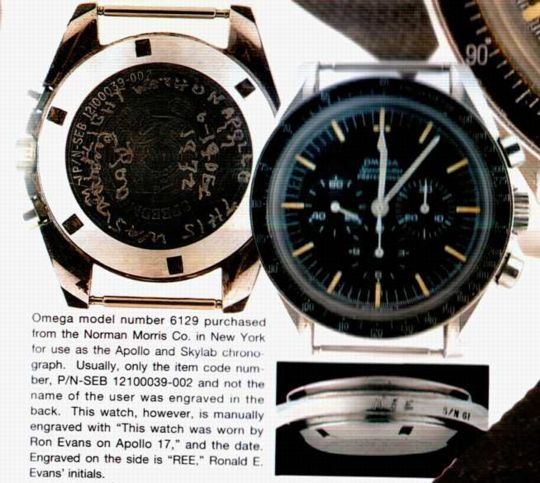-
What
we know about the watches that were worn
on/near the
moon...
- [originally
posted under: I swear! I'm going
post this as a TZ Classic this
time!]
-
- Posted By:
Chuck
Maddox
<cmaddox@xnet.com>
Date: 6/18/0 - 11:02:59
- In Response
To: Let's
resolve this Speedmaster Moon question
once and for all...
(SideB)
-
- [For
brevity and conciseness I have edited a
couple of responses together to keep
things manageable... I have also cleaned
up some of the numbered points to be more
chronological in nature... -- Chuck Maddox
19 June 2000]
- Here
is what we know, or have been able
to determine:
Accoding to
Imai's Time Capsule:
Speedmaster's
relationship with outer space began when
NASA's flight equipment buyer went to
Corrigan's watch shop in Texas to purchase
a chronograph. This was in 1961. At that
time, the NASA flight equipment buyer
purchased five chronographs, all of
different brands, including the Omega
Speedmaster. The intended use for the
chronographs was not made clear. What
brought the NASA equipment buyer to a
jeweler's on a Texas street comer was most
likely none other than President Kennedy's
speech.
NASA procured a
large number of Speedmaster's during the
1960's for use as an Space Flight Crew
chronograph after extensive testing prior to
the first Gemini flight.
Note:
We don't know the number or specific
model(s) that were acquired but this was
done before the switch over to
c.861 movement.
In 1966 Omega
added the term "Professional" to the
Speedmaster after becoming aware of NASA's
adoption of the Speedmaster. I have
previously written a companion TZ Classic:
1278
: It was 35 years ago today - (4 June 1965 -
4 June 2000)
which details the events leading up to Ed
White's space walk.
There
are really only two people that are really in
a position to know which movement was the
first watch worn on the moon for certain:
Neil Armstrong and Edwin (Buzz)
Aldrin.
|
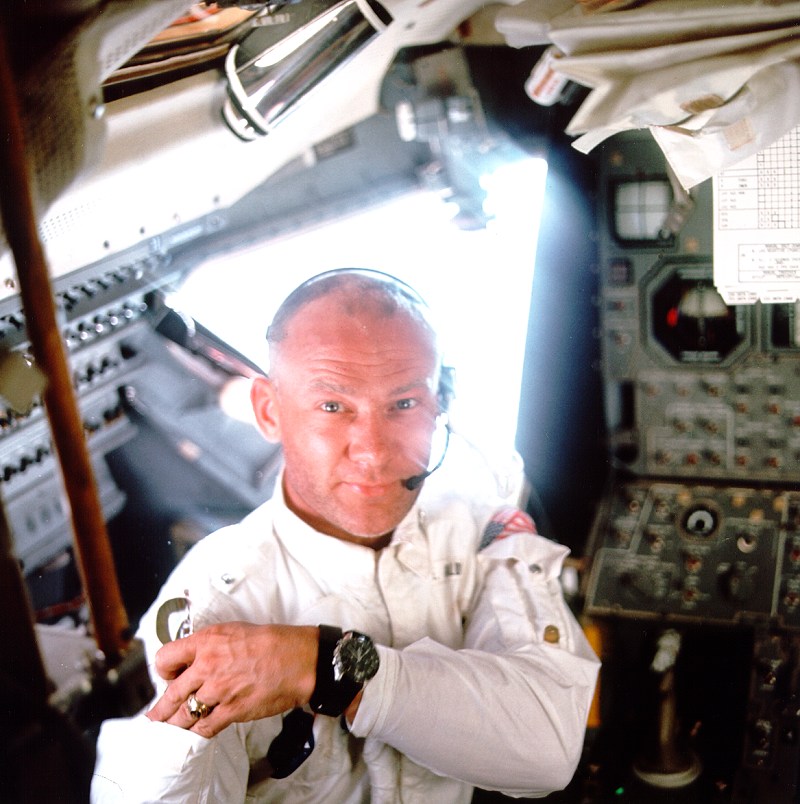
|
It
has been documented that Armstrong did not wear
his Speedmaster on his walk on the moon. An
instrument had malfunctioned during the LEM's
Decent and his Speedmaster was left in the LEM
to serve as a replacement.
[Armstrong,
from the 1969 Technical Debrief -
"Now,
a preliminary comment (on the EVA Preps) has
to do with the longer time that it took than
during our simulations. It is attributable to
the fact that, when you do simulations of EVA
Prep, you have a clean cockpit and you have
all the things that you're going to use there
in the cockpit and nothing else. In reality,
you have a lot of checklists, data, food
packages, stowage places filled with odds and
ends, binoculars, stop watches, and assorted
things, each of which you feel obliged to
evaluate as to whether its stowage position
is satisfactory for EVA, and whether you
might want to change anything from the
pre-flight plans. For example, our mission
timer was out, and we decided we had better
leave one wristwatch inside in case it (the
one taken outside) got damaged. We would have
at least one working watch to back up the
mission timer or to use in place of the
mission timer, in case we could not get it
going
again."]
... [The astronauts each had an Omega
Speedmaster Professional.]
Source:
Apollo
11 Lunar Surface Journal: EVA
Prep...
Later
on in the log the following conversation
transpires:
- 108:54:54
McCandless: Neil, this is Houston. Will
you give us hack when you start your
chronometer. Over.
- 108:55:03
Armstrong: Roger.
- 108:55:08
Aldrin: Give it to them later.
- 108:55:12
Armstrong: Okay. Okay, let's go to
dump.
- 108:55:17
Aldrin: Dump.
- 108:55:18
Armstrong: Go to dump. (Long
Pause)
- 108:55:40
Aldrin: Houston, I'll set my watch at 56.
Over.
- 108:55:50
McCandless: Roger.
- [Buzz
is wearing his watch on his suit sleeve
and, apparently, is setting his at 56
minutes after the hour, corresponding to
the upcoming Ground Elapsed Time of
108:56.]
- 108:56:00
Aldrin: 3, 2, 1.
- 108:56:02
Aldrin: Mark.
- [Buzz
reopened the dump valve on his mark. This
is the start of the EVA.]
- [Aldrin
- "I'm sure that Neil didn't
wear his watch out on the surface. I'm
sure he put it with the Velcro strap up in
the AOT."]
- [Armstrong
- "Someone, perhaps in correspondence,
asked me about that. And I could not
remember, although it seems quite logical,
given the mission timer situation, that we
would have left one watch
inside."]
-
- Thus
it is apparent that Aldrin's
Speedmaster was the first worn on the
moon.
It
has also been documented that Aldrin's
Speedmaster was lost and presumed stolen in
transit to the Smithsonian for inclusion in it's
displays:
[Aldrin -
"I wasn't sure what the reason was, but I
thought it was okay. It was your watch, if
you wanted to leave it inside. I remember
that specifically at that time, because I
reflected back on it a little later when I
shipped my watch to the Smithsonian and it
turned up missing. That's when it
refreshed in my mind, years ago, that you had
left yours inside and mine was the only one
out on the surface."]
Thus
we cannot point to the actual watch to
determine it's movement.
|
|
Photos
of Moon Mission Astronaut watches:
The Time Capsule
book has pictures of two of the Moon Astronauts
Speedmaster's (Alan Sheppard, commander Apollo
14 [a moonwalker], and Ron Evans [CM
Pilot for Apollo 17].
Exhibit 1, Alan
Sheppard's Speedmaster (Click on picture to
enlarge):
This watch,
manufactured in 1966-1967 is almost certainly
a c.321. It couldn't be anything other than a
c.321.
Exhibit
2, Ron E. Evan's Speedmaster (Click on picture
to enlarge):
This watch also
appears to be a c.321 model of the
Speedmaster.
Be sure to
note the S/N:
61
engraved on the side of this Speedmaster...
We
will come back to this.
There
are no other pictures of Moonwalker's
watches available, to my knowledge, that
would clearly show which model they
wore. There are plenty of pictures of the
astronauts wearing their speedmasters on
the moon and during missions but I have
not found any photos that clearly
show which model they are using.
|
|
The
Issue of Jack Swigert's Rolex GMT...
Information from
James Dowling and Jeffrey Hess Rolex
Book
In the book "The
Best of Times: Rolex, an unauthorized
History" James Dowling and Jeffrey Hess note
that "It was a GMT-Master on the wrist of
Jack
Swigert
that helped the crew of Apollo 13 to make it
back to earth safely after their on-board Oxygen
tank ruptured".
Dowling
and Hess acknowledge that recorded history
states that it was Lovell's Speedmaster that
timed the engine burns that saved the craft.
They state "It was a GMT-Master on the
wrist of Jack Swigert that helped the crew of
Apollo 13 to make it back to earth safely
after their on board oxygen tank
ruptured.". However they do
not elaborate on how the GMT-Master
was helpful.
Jack Swigert
later had this same watch mounted with a
photograph of the splashdown, a mission patch
and the note "To my long-time friend
René Jeanneret who enabled me to
always be on time. With sincere thanks, Jack
Swigert". This is pictured on pages 276
and 277 in the book.
Dowling and Hess
also state that it could be argued that the
only reason the astronauts wore Omega's in
the first place was due to a foul-up in the
New York City office of Rolex. A lack of
available GMT-Masters on hand allegedly
forced NASA to go elsewhere for Astronaut
watches.
This
theory (or argument)
doesn't hold seem to hold a much water
with the perceived problems of using the
automatic movement that the GMT's were
equipped with (which Dowling and Hess
mention in the next paragraph), the
extensive documentation from NASA about
the specifications for a
Chronograph not
merely a watch, or the established facts
that a Rolex Chronograph was tested
alongside the Speedmaster among others. It
seems to be have significant issues to
state conclusively that the Rolex was
used. It seems to be a weak argument at
best, revisionist history at worst. I have
a great deal of respect for Mr. Dowling
and his Rolex Book which I consider the
mark to shoot for when it comes to books
on watches. But I wouldn't have gone on a
limb like that....
NOTE:
Special Thanks to Paul
Schliesser,
who is creating a
history page for Gruen
watches,
for tipping me off to the information
about Jack Swigert's Rolex in Dowling and
Hess's book!
TV/DVD
Documentaries:
On 22
January 2001 the History Channel ran an
episode of Modern
Marvels: Apollo 13
that featured a good deal of archival footage
shot during the Apollo 13 mission... I saw at
least TWO separate shots showing Jack Swigert
wearing a Speedmaster with a Velcro strap on
his _right_ wrist... Thus the question about
whether Swigert wore a Speedmaster during 13
can be answered... It appears that he did.
Possibly in addition to a Rolex GMT, possibly
not.
You
should be able to contact the History
Channel and order
a copy on tape of the show I
mention,
and see for yourself...
In addition
there is available on DVD a documentary on
the Moon missions entitled "For
All Mankind"
that also has expensive footage of the Apollo
13 mission. In this footage as well the only
watch that is visible on Swigert's wrist is a
Speedmaster.
In both of the
above cases only the Speedmaster appears on
Swigert's wrist, but in all instances he is
wearing multiple layers of long-sleeved
clothing and it is quite possible that
Swigert had his GMT under a cuff. Especially
with the following point...
Photos:
Recently
in both the Omega and Rolex Forums this topic
of which one watch (or both) did Jack Swigert
wear on Apollo 13. Hung Doan
was kind enough to post pictures of Jack
Swigert before and after the Apollo 13
mission:
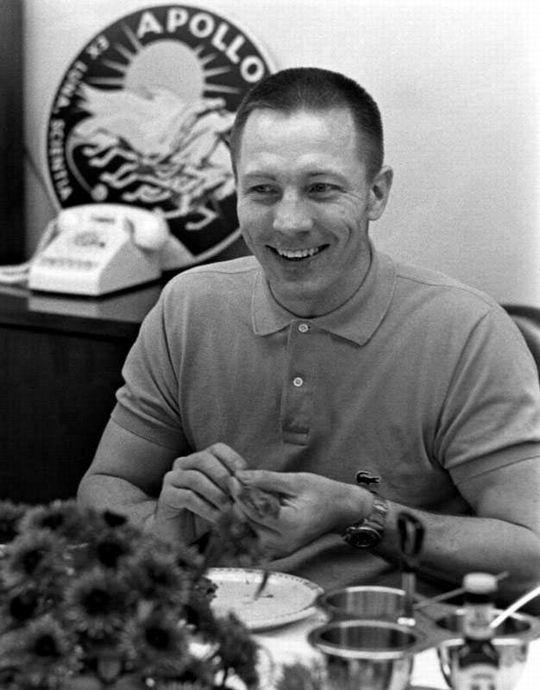
|
- Jack
Swigert at pre-launch Astronaut
breakfast clearly wearing a
non-chronograph that looks like a
GMT.
- (Click
on picture to
enlarge)
|

|
|
Swigert
with what looks like a 1675 GMT
w/oysterlock bracelet.
|
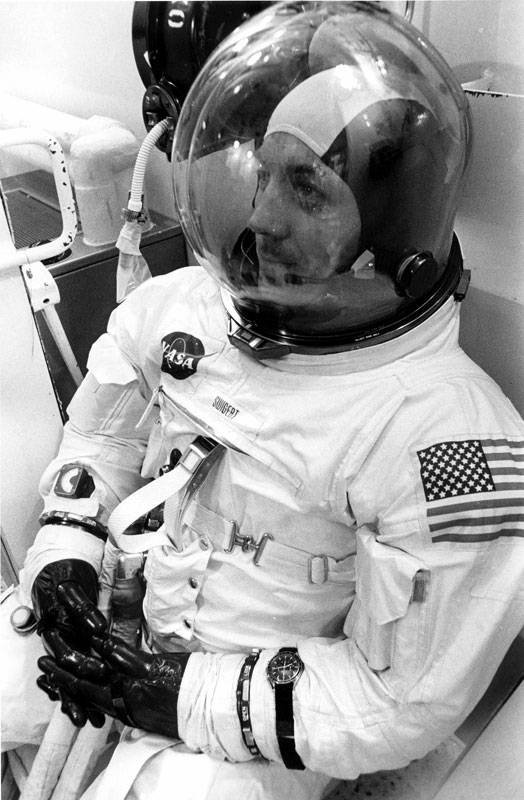
|
|
Swigert
Suited for Launch with a Speedmaster
Velcro Strapped to his left wrist.
This is probably the Speedmaster
which timed the mid-course burn so
critical to the return of Apollo
13.
|
|
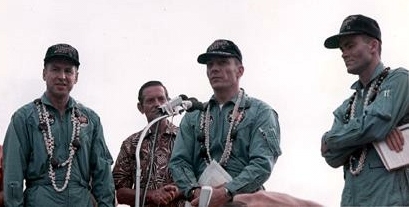
|
- The
Apollo 13 Crew after the mission
(Astronauts Lovell, Swigert &
Haise,
- from
Left to Right). This shot is most
likely from Hawaii where
President Richard M. Nixon
awarded them the Medal of
Freedom.
|

|
|
Swigert
clearly wearing two watches (inside
yellow box)...
|
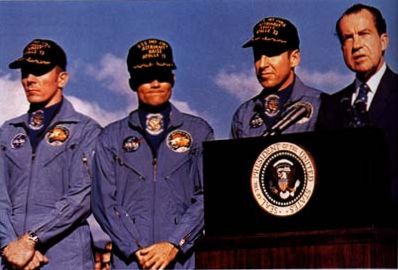
|
|
Swigert,
Haise, & Lovell (L to R) at
Medal of Freedom award w/President
Nixon.
|

|
|
Close
up of Swigert's
GMT...
|
|
|
So it is probably
safest to say that Jack Swigert probably wore a
GMT Master in addition to his NASA issued
Speedmaster...
However, Swigert's
GMT would not have made it to the moon because
Swigert was Apollo 13's Command Module Pilot and
would have remained in Lunar orbit had the
mission not been aborted.
Sadly, we can not
ask Jack Swigert himself about which watch(es)
he wore because he passed away from
complications related to cancer in Washington DC
on December 27, 1982, a week before he would
have taken the congressional seat he won in the
Sixth Congressional District of Colorado in the
November 2 election of 1982.
Special
Thanks to Hung Doan for providing the photos
for this section!
|
|
However,
we can dispel the myth that the Speedmaster was
the only watch worn on the
moon.
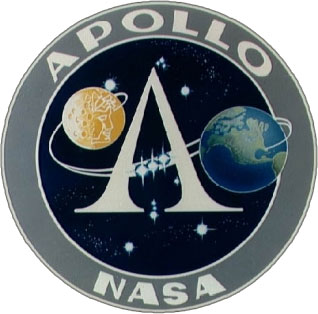
From Apollo XV,
astronaut David Scott:
- 142:14:22
Scott: "Verify cabin at 3.5." Okay, cabin's
at 3.5. Suit circuit's locked up at about
4.4. My PGA is coming through 5 and decaying.
And let's slip on a watch.
- [Dave
may have had his watch hanging from the
instrument panel and, in any event, he is now
putting it on and is probably starting the
stopwatch function.]
- [Scott,
from a 1996 letter - "I do not recall ever
having looked at my watch after egress. In
the cabin after EVA-2, I noticed that the
crystal of my Omega had popped off
sometime during the EVA. Therefore, on
EVA-3, I used my backup Waltham watch (which
was) of a similar type. It worked just
fine during the even higher temperatures of
EVA-3.]".
-
- (Source
NASA's
Apollo 15 Lunar Surface
Journal,
Specifically EVA-2
Prep page...)
- [Quick
find hint: do a find on "142:14:22"
within the EVA-2
Prep Page]
-
- Hence, We
can clearly shoot down the notion that
the Omega Speedmaster was the only
watch worn on the moon. We have direct
testimony on NASA's site from a "Moonwalker"
that he wore a Waltham on the
moon.
People have asked,
"What does this Waltham that Scott wore look
like?"… The short answer is I don't
know. But one of the few
“Waltham
watch (which was) of a similar
type”
made and offered to the general public during
the timeframe when David Scott could have
purchased one for use as a backup watch on
Apollo 15 that I've seen in my searches is this
model:

I purchased one of
these off of eBay in 2002 for the Princely sum
of $155 (which remains my least expensive manual
wind chronograph purchase - Only a couple of old
Seiko and Citizen Bullhead Automatic
Chronographs have come to me cheaper) and I
offer a picture of my Waltham that
might be a similar or same
model as the one David Scott wore:
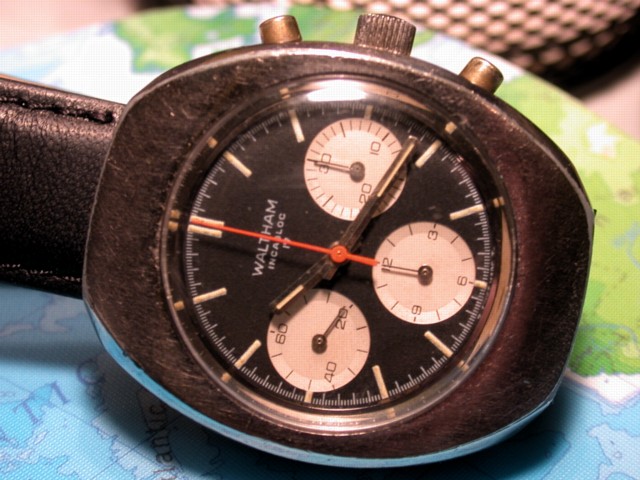 -
- Additionally, I
have recently come into possession of another
Waltham Chronograph of a similar design to
the Speedmaster which might be a possible
candidate for Mr. Scott's
Waltham:
-
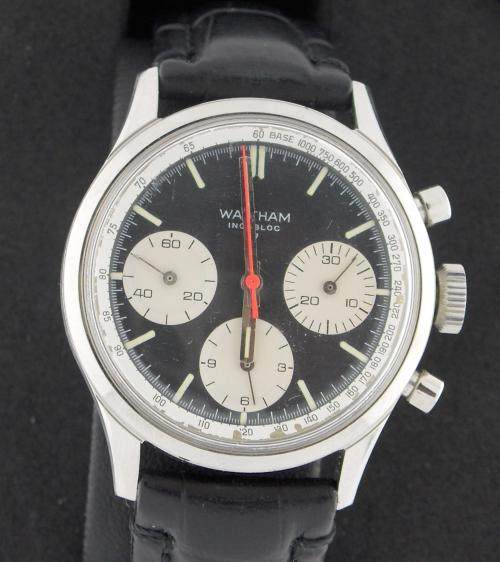
- This model does
appear to be closer in appearance to a
moonwatch with the exposed lugs. Both watches
sport a Valjoux 7736 movement which was in
production and on dealer's shelves for some
time prior to the Apollo 15
mission.
-
- Another
possibility for David Scott's Waltham was
forwarded to me by a D. Lee Brandt in
December 2004. I
discuss that watch and it's potential as Mr.
Scott's Waltham on my Blog...
-
- Mr. Scott's
Waltham could be any of these models, or a
different model. The only way to find out for
sure is to interview Mr. Scott. Anyone have
an address?
-
- January
2007 David Scott's Waltham
update:
- [since this
information is specific to David Scott's
Waltham, I'm including it here instead of an
addendum at the end of this
document]
-
- On Jan 22,
2007, 09:00 AM in the TimeZone Omega Forum,
Christopher Meisenzahl posted:
-
Unauthorized
Timepieces
Another
irregularity that has come to light in the
investigation of Apollo 15 was that Scott had
on board two timepieces (a wristwatch and
stop watch) that were not part of the normal
mission equipment. During the preflight
training period, Scott had agreed to evaluate
these timepieces for the manufacturer at the
request of a friend. Thinking they might be
useful, particularly for the possible
emergency timing of a manually controlled
propulsion maneuver, Scott carried them on
the mission but without prior authorization.
NASA has deliberately withheld the name of
the manufacturer of the timepieces to avoid
commercialization of this unauthorized
action.
Source:
http://www.collectspace.com/resources/flown_a15_articlescarried.html
-
- Which gives us
more information on how the Waltham
Chronograph (and indeed a heretofore unknown
stopwatch) came to be on board Apollo 15.
There is additional
discussion on this topic in this
thread
opened by Peter C on TZOF...
-
- To this day,
Omega claims both in print advertizement and
as of lately on the backs of display back
Speedmasters that the "moonwatch" is
“The first and only watch
worn on the moon”.
-
 -
- This is
not factually correct. Omega
probably considers the Waltham being on the
moon to be a bit of a "stowaway" situation
and feels free to continue to use their
"first and only" catch phrase. To be frank, I
have some sympathy towards Omega on that.
However, the fact remains... Regardless of
how it got there, a Waltham was worn on the
moon. And thus the slogan isn't factually
correct even if the Waltham got there
illegitimately.
-
- EMail's
from John Diethelm, head of Omega Vintage
Information (until his recent
retirement):
-
We
have TZ
Classic 381
in which John Diethelm of Omega Vintage
Information is quoted as stating:
"Dear
Sir,
In reply to your
net inquiry dated febr. 19,1999 here are some
details:
1. it is obvious
that the first moon landing was made with a
Speedmaster fitted with a caliber 321
movement. The toward the seventies, the NASA
has probably also used the replacement
movement caliber 861. We have no official
confirmation of what has been used and when,
except for the first Moon landing.
2. The
re-qualification in 1978 is exclusively made
with the caliber 861."
Kind
regards
OMEGA LTD John
Diethelm
Note:
This is not necessarily true, because we
do have the photo's above and additional
pertinent information below. But, I
present it as is nonetheless.
Dave
S. posted, on 1 August, 2000 in the Omega Forum,
an email from Omega PR (John R. Diethelm)
regarding the ST 145.0120-67 model:
Dear Sir,
further to your
above inquiry, we have compared your
information and have therefore the following
available details:
* mvt N°
xxxxxxxxxx * manual winding chronograph
movement of Calibre 321 - 17 jewels * case
reference: ST 145.012 - stainless
steel * manufactured and delivered to our
Agents in Danemark on October 25, 1968.
It is
confirmed that the OMEGA Speedmaster
chronographs that went to the " Moon " were
of identical reference as your above
watch.
best regards
John R. Diethelm
/ Public relations
Hence
does seem most likely that the c.321 was
the movement used in (most of) the
watch(s) worn on the moon... (Thanks, Dave
S.!)
Lastly we have the
issue of when were c.861's first officially
used... The truth of the matter is that we
really don't know. We know that:
Omega made
a special commemorative watch (250 pieces)
with the Apollo-Soyuz mission at 12 o'clock
on the dial.

From the
pictures of that mission [Pages 136-137
in the Time Capsule Book] we can see
that:
 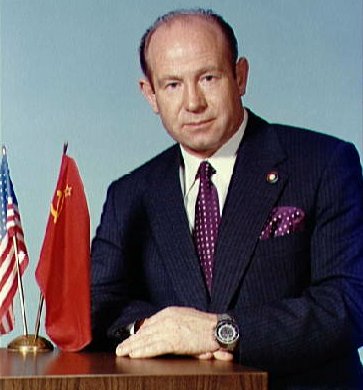
- Alexei
Leonov is clearly pictured wearing a
Flightmaster.
- However,
it is unclear if the photo of Alexei
Leonov was taken during the mission,
prior or after the mission.
- We know
Cosmonaut Leonov was pictured
officially wearing a Flightmaster, but
did he actually wear it on the mission?
We don't know.
- Tom Stafford
and Vance Brand are pictured wearing a
Speedmaster but it does not appear to be a
commemorative model (no red/blue in the
dial)
- But there
is a glare on crystals in these photo's
so I can not say if they are applied
metal logo'ed Speedmasters, or White
Painted.
- But it
is clear enough to see at least two
or three lines of text not the one
of the commemorative
model.
- Donald
(Deke) Slayton appears to be wearing
a non-commemorative Speedmaster and
the picture is clear enough for me
to believe it has a Applied Metal
(read as c.321) logo'ed dial.
Considering Slayton was with the
Astronaut Corps from the beginning
this is consistent with other facts
stated above.
|
- What
can we conclude as fact?
- NASA's flight
equipment buyer visited Corrigan's watch shop
in Houston Texas to purchase five
chronographs, all of different brands,
including the Omega Speedmaster in 1961 for
testing purposes.
- NASA first
procured watches for the Astronaut Corps
after Project Mercury and before the
introduction of the c.861
movement.
- Speedmasters
were tested again in 1972, as a result of the
efforts of Omar Bradley and the Bulova Watch
Company to get their own chronograph used on
the final Lunar landing mission, but it is
unclear if NASA procured them or if they were
merely submitted for testing...
- I nor anyone
else I know who has attempted have been
unable to find any documentation of NASA
procuring additional Speedmasters after the
introduction of the c.861 prior to the 1978
retesting for the Shuttle
missions.
- According to
John Diethelm (who is as close to Canon as we
are likely to get aside from speaking to the
actual Moonwalker's [at least two of
which have since passed away]), the first
watch worn on the moon was a c.321 worn by
Aldrin.
- John Diethelm
also states that the ST 145.012 was the case
reference of the Speedmaster chronographs
that went to the " Moon ".
- We can document
that Alan Sheppard's and Ron Evan's
Speedmasters were c.321's. NASA seems to have
c.321's in each of the instances we have been
able to document.
- Omega has no
official confirmation of what has been used
and when, except for the first Moon
landing".
- That
Jack
Swigert
with almost 100% certainty wore a Rolex
GMT-Master on the abortive Apollo 13 mission.
In footage shot during the Apollo 13 mission
I've only seen the Speedmaster visible. But
it is probable and likely that he wore the
GMT under a cuff as there are pictures of him
wearing a non-chronograph prior to the
mission and two watches afterwards.
Unfortunately Mr. Swigert passed away some
years ago of cancer so we can not simply ask
him...
- David Scott
wore a Waltham Chronograph on the surface of
the moon during the third EVA of the Apollo
15 mission.
- Which points
out additional facts:
- Astronauts
were permitted to and did wear
personally purchased watches on Apollo
missions as backup's to their NASA
mandated and provided
Speedmaster's.
- Astronauts
could easily have worn any one of a
number of other watches on the moon
other than Speedmasters in general, and
c.321's in particular.
- Thus it is
possible that an Astronaut could have
purchased a Speedmaster Pro c.861 as his
backup watch.
- Indeed it is
possible and maybe even likely that
some c.861's were worn on the moon by
Moonwalker's:
- "The toward
the seventies, the NASA has probably also
used the replacement movement caliber 861"
-- John Diethelm from within
TZ
Classic 381.
- However,
looking at the wording of John's quote, it is
written in a way that leads me to believe
this is a speculation on John's part, not a
fact.
- We really don't
know specifically what watches were worn
during the other moon missions, or the Skylab
missions.
- It appears that
the Apollo-Soyuz Astronauts did not
wear commemorative c.861 model
Speedmasters
- It appears
that Deke Slayton might (and probably)
wore a c.321 during the ASTP (Apollo-Soyuz
Test Project).
|
- Here
is the bottom line:
- Omega has
stated as fact that the first watch worn on
the moon (as referenced previously) that the
first moon mission was equipped with c.321
Speedmasters, ST145.012- 's.
- We have two
documented cases where a moonwalker
(Sheppard) and one orbiter (Evens) wore
c.321's
- We have no
documentary evidence to prove that
c.861's were used on or near the moon,
although we have reasons to suspect
that some were used among other brands of
watches. This is the rub for c.861's... We
can not document their use on or near
the moon at all.
- The Speedmaster
was not the only watch worn on
the moon (David Scott as referenced
previously wore a Waltham on his last EVA.),
nor the only watch worn in the vicinity of
lunar orbit (Jack Swigert's Rolex
GMT-Master).
- Those are the
facts of the matter as I have been able to
determine them, and for the most part have
typed up in the forum at least twice
previously. The only difference is that
previously I believe I may have stated that
the c.861 was used on the Apollo-Soyuz
mission. I no longer believe that I can
conclude that the c.861 was definitely used
or not, and it appears to me in reviewing the
photo's in the Time Capsule Book, that Deke
Slayton wore a c.321.
-
- I honestly
believe the best and perhaps the only way to
nail down for sure what watches were worn
when, aside from what I and others have
documented, is to ask the astronauts
personally. I believe that may be the only
way to satisfy people, and maybe even that
wouldn't be enough.
-
- Now
for a personal note.
-
- Everything
above is factual to the best of my knowledge.
Where I have speculated, I've stated so, or
worded the thought in such a way that it
should be clear that it is an opinion. We
can prove (at least to my
satisfaction) that c.321's were worn
on the moon, and that a Waltham of a
similar type to the Speedmaster was worn on
the moon. However, I and others have
not located any
proof of other movement's/watches
(other than the Waltham) having been worn on
the lunar surface, only speculations and
opinions that it may have
happened.
-
- Is the c.861
Speedmaster worn by the Moonwalker's? I can
not state so because I have not seen
proof that it was. I have seen
evidence to prove that c.321 Speedmasters
were worn on the moon. Thus, the c.321
Speedmaster was worn on the
moon (at by least Aldrin and probably
Sheppard). The c.861 might also
have been worn on the moon by Moonwalker's,
but neither I or anyone else has been able to
document it.
-
- I have no axes
to grind, no biases to bolster, no desire to
promote false information, imply opinion as
fact, ego's to massage or bruise, nor wish to
cause monetary values to raise as I am not
looking to sell any of my moonwatch cased
watches.
-
- I hope this
shed's a proper light on the subject and that
if someone (ANYONE) has evidence to bolster
the case of the c.861 you will come forward
and let me know. My e-mail address is
below... Thank you in advance!
-- Chuck
(cmaddox@xnet.com)
|
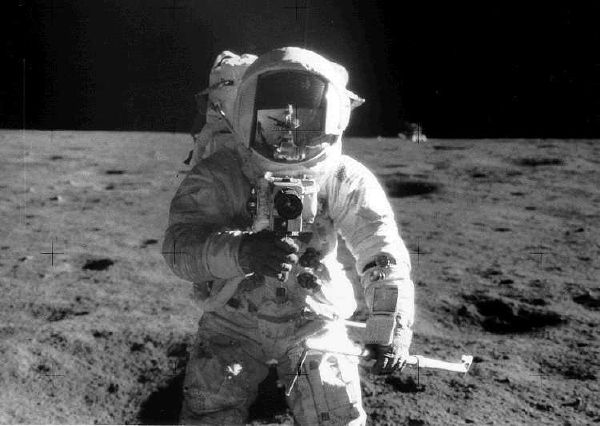
|
- Addendum's...
We frequently get queries in the Omega Forum
on this subject despite the existence of this
document asking about this subject. Rarely is
there anything new of note posted on the
subject, however sometimes there are
interesting facts or thoughts added to the
discussion on this topic... These are
reproduced here for completeness...
11
January 2001 Addendum...
-
- The posts of
the week of 1/7/2001-1/11/2001 pursued a
couple of interesting tact's... These are
reproduced here...
-
- Damon
is quoted on the following two statements
(bolded and italicized). My response follows
in plain text.
-
- Still
really unknown as the which was the first on
the Moon but I think it was the
321.
- We really don't
know for 100% certain, and we likely
never will... The only way to make
certain would be to examine Buzz Aldrin's
(who
is documented as wearing the first watch worn
on the moon)
example, but Aldrin's Speedmaster was stolen
while in transit years ago.
-
- John Diethelm
has stated in a number of occasions that it
is certain that Aldrin's Speedmaster was a
c.321. I accept that but there is still a
remote possibility, but greater than 0%, that
John is in error and Aldrin wore a c.861. I'd
put that remote possibility at less than 1%
chance, but yet it still exists. Thus we can
say it's all but certain that Aldrin
wore a c.321 but we have to have that "all
but" qualifier in there because we are not
100% certain... Or at least I'm not 100%
certain.
-
- Although,
ones with the 861 movement have been to the
Moon on late missions.
-
- I have not seen
any solid evidence to support this
statement... I've written about this at great
length, most recently on Friday January 5,
2001. Here is an excerpt:
- NASA
tested and decided on Speedmaster's in
1965, They were worn throughout the Gemini
missions, first becoming known as NASA's
choice via pictures of Ed White's
Spacewalk in June of 1965. This is why I
sometimes call my ST
105.003-65
the "Ed White model/style" Speedmaster. In
January 1967 the Apollo 1 occurred and Ed
White along with Gus Grissom, and Roger
Chaffee lost their lives with their
Speedmaster strapped to their space suits.
I've heard and read that Ed White's
Speedmaster was given to his
son.
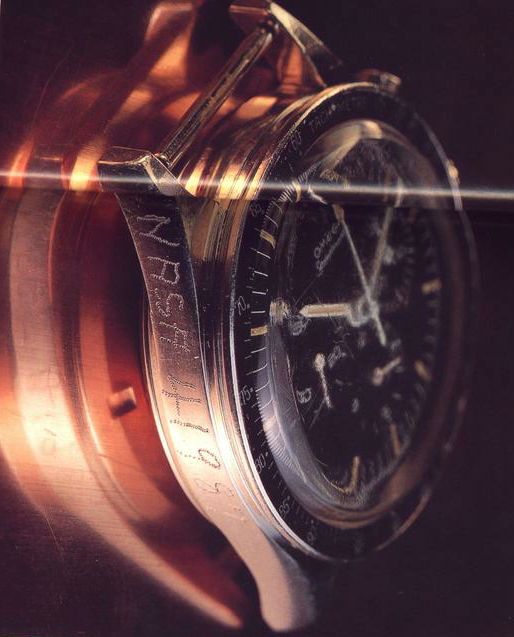
|
- The
First watch worn in to space...
- Edward
H. White II's NASA Issued
Speedmaster
(ST105.003)
|
|
- In 1968
Omega switched from c.321 movement to the
c.861 for the Moonwatch. NASA also launched
Apollo 7 and 8 in October and December
respectively. In 1969 Apollo 9 (March),
Apollo 10 (May) led up to Apollo 11's landing
in July 1969. We have it in good authority
from John
Diethelm of Omega Vintage
Information
that Aldrin's Speedmaster was a c.321,
Specifically a ST
145.012.
It is also fairly doubtful that there would
be enough lead time for c.861 Speedmaster's
to trickle down through the distribution
system by this time for Aldrin's to have had
any possibility of being anything other than
a c.321. Apollo 12 finished up 1969's Apollo
Moon explorations in December of 1969. Apollo
13 was the only manned American Space flight
made in 1970, because of the problems
experienced with it, Apollo 14 flew in early
1971, Apollo 15 also flew in 1971, Apollo's
16 and 17 finished up the early manned
exploration of the moon in
1972.
-
- So while it is
not very likely that c.861's could possibly
have been the first watch worn on the moon
there is the possibility or at least a window
of possibility that a c.861 did get aboard in
the 1970-1972 timeframe.
-
- For the record,
Retired General Omar Bradley on the behalf of
the Bulova watch company pressed NASA on the
issue of Astronaut watches. Bulova wanted to
have the prestige of having an Astronaut
watch on the last Apollo moon mission. The
tactic they used was a Buy American Act,
Bulova felt that the Swiss made Omega was in
violation of this law. They produced an
"American made" chronograph of their own
manufacturer to compete. It failed and the
Speedmaster was used for the final mission. A
result of this was an answer to the question
of where all the Astronaut watches had ended
up. Being government property there is an
obligation to return them after use or to
reimburse the government for their expense.
Bradley asked where they had ended
up.
-
- In
a panic NASA made a survey of the locations
of these watches. Since 1964 NASA had
purchased 97 chronographs. When making
purchases NASA had requested only Omega
Speedmasters (note: for all purchases before
1968, NASA would simply have to specify
Speedmaster's because there was only one
model of Speedmaster until the Mark II
appeared in 1969). This group of 97
chronographs were used on all manned missions
beginning with Gemini 3. Of the 97: 17 could
no longer be used or were lost. In 1972 there
was an inventory of 20 unused units at the
flight center. The remaining 60 units had
already been used or had undergone repairs to
bring them up to specifications. (Time
Capsule, Page 135). This also implies that
Speedmasters worn during the Mercury project
were purchased by the individual astronauts
themselves (although again this is an
implication, not a documented fact). Note:
Ron
Evans S/N: 61 Speedmaster pictured
above
would seem to fit within this
number...
-
- Thus it seems
very unlikely that NASA would use c.861
movement Speedmaster's which had not been
tested for compliance to NASA standards when
they had 20 unused Speedmasters in inventory
already.
-
- There remains
three other way's for an c.861 to have
possibly made it to the moon:
- Astronauts
are allowed to wear a backup watch of their
own choosing in addition to their required
Speedmaster.
- It has
been stated in the Unauthorized Rolex book
by Dowling and Hess. that Jack Swigert
wore a Rolex GMT Master on Apollo 13
(although in all films I have seen of that
mission Swigert appears to be wearing a
Speedmaster only) and that a Waltham
Chronograph was worn on the moon by David
Scott during Apollo 15's EVA-2 when the
crystal of his Speedmaster was lost during
EVA-1.
- Personal
Effect's Kit's:
- Each
astronaut was allowed to have packed on
the spacecraft a personal effect kit
weighing less than one pound. Most
astronauts included pictures of family, or
similar effects, Buzz Aldrin took a
communion kit, etc.
- An
Astronaut replaced his issued Speedmaster
with an off the shelf model.
- Conceivably,
an Astronaut could have damaged or lost
his issued timepiece and replaced it on
his own without telling anybody.
- So it is
possible that an Apollo astronaut purchased a
c.861 on their own as either a backup watch
to their primary watch, or to put into their
personal effects, or replaced the NASA issued
watch for whatever reason. It's also quite
possible that an astronaut purchasing a
Speedmaster would be ignorant of the movement
change in the watch. Thus these are
possibilities but they don't
seem particularly likely.
-
- So I say that
it is most likely that most, if not all the
Speedmasters worn on or near the moon were
c.321's. It is possible that a
c.861 slipped aboard some of the later
missions, but not terribly likely and
definitely not certain. It is also known that
Speedmasters were not the only watch worn on
(Scott's Waltham) or near (Swigert's Rolex)
near the moon. So even Omega's assertion that
the Steel Back moonwatches assertion of being
"the First (true) and only (false) watch worn
on the moon" is incorrect even if you
consider the c.861 (and 861 family) as
legitimate "moonwatches".
- You can choose
to say that c.861's made it to the moon, and
while you may be right, I have been
unable to find any evidence that any
evidence which isn't an opinion or conjecture
that c.861's did make it to the moon. I for
one can not state that they
did, only that there is a small
possibility that they
might have made it on to a
later flight, because I can't find and
reliable evidence that proves that they did
make it, somehow, on a later
flight.
-
- I should also
mention that Michael Stein and myself
extensively debated the topic of "Did c.861's
go to the moon?" in the TimeZone Omega Forum
in October of 2002. I was able to archive
those posts and actually have them available
for viewing but I'm looking for a way of
presenting those links in a cohierent fashion
before posting them for public view. If you
wish to view the "raw" archives,
email
the author
and I'll be happy to point you to
them.
-
-
Russ asked a couple of followup
questions (bolded and italicized). My
response follows in plain
text.
-
- - Are you
saying that all 97 chronographs were
purchased pre-1968? Or, is this the total
number purchased from 1964-1972 when Bradley
asked about the location of all the
watches?
-
- The Time
Capsule (p. 135) says "Since 1964 NASA had
purchased"... So the implication is that
these watches were purchased between 1964 and
Bradley's query... The book did not specify
when NASA's last purchase in that timeframe
was.
-
- - I
assumed there were periodic purchases by NASA
as astronauts were added, and that 861's
would have been in the later purchases (post
1968). Comment?
-
- I'm only
posting what I've seen. It's possible
that NASA made purchases after 1968, but I
have not seen any (not one) reference that
NASA bought any additional Speedmasters after
their initial purchase to fulfill the needs
of the then established programs
(Gemini/Apollo). Remember that the Apollo
program was projected to have lunar landing
missions through Apollo 20 but sadly Apollo's
18 through 20 were canceled because of budget
cuts. It would be consistent with three
additional missions (with 3 astronauts, 2
watches, 3 missions = 18) that NASA had 20
unused Speedmaster's on hand...
- It is possible
that they did purchase additional
Speedmasters, but neither I nor anyone I've
known has ever shown me a speck of evidence
to support such a contention.
-
- -
My Speedmaster purchased last year doesn't
say this. Rather it states "Flight-qualified
by NASA for all manned space missions. The
first watch worn on the moon." Do the older
Speedmaster say "... the only watch worn on
the moon..."? Just curious.
I don't believe
that the watch case back has ever said
"only" [Until
2003 it hadn't, but Omega changed the
displayback model to read "First and Only
watch worn on the moon" about this time --
Chuck],
but much of Omega's advertising through the
years has stated "First and Only Watch" or
"only watch" or some variation...
- For
example:
 - and
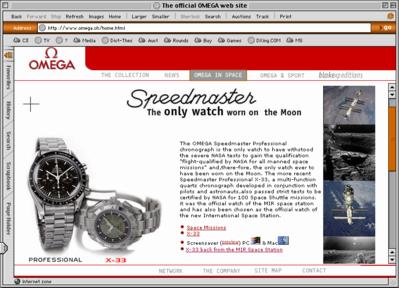
|
|
|
|
|
Description:
|
|
Caseback:
|
|
|
|
|
|
|
|
Post-Moon
Professional Speedmasters (1st
Generation):
Shortly
after the successful landing by Apollo
astronauts on the moon Omega moved to
commemorate the event by means of a
specially engraved caseback... The
exact beginning and ending date of this
caseback is not well known, but usage
started in the late 1969 timeframe and
lasted until some point in 1971 when
the modern caseback was adopted. This
is the caseback found on ST145.022's
dating from after the first lunar
landing to roughly 1971.
|
|
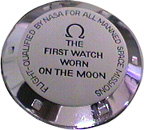
|
|
|
Post-Moon
Professional Speedmasters (2nd
Generation~Current):
The
currently used caseback has been in use
from 1971 through the currently sold
non-commemorative non-display back
model,
|
|
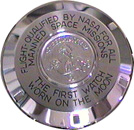
|
|
- Johan
Axelsson asked the following
questions:
-
- Did the
astronauts use the same watch from mission to
mission?
-
- It is my
understanding that when Astronauts were
accepted into the Astronaut Corps they were
issued two (2) Speedmasters. At least this is
the case with 1960's era astronauts. This may
have changed since then.
-
- I think I
read a thread in this forum a year ago about
the Speedmaster of astronaut Ed White.
According to this thread (I don't remember
who was the author) one of the son's of Ed
White had got the Speedmaster of Ed White
after the tragic accident in January 1967.
This son had written a letter that was
published in a Japanese book about The
Speedmaster Pro. According to the letter this
Speedmaster was the very same watch that Ed
White had been wearing during his historical
Gemini 4 EVA.
- I remember the
thread in question, it was probably the first
time I had typed up what had eventually
became my TZ classic post on the subject. If
I remember correctly, the author of the post
referring to Ed
White's
son had written a letter that was refereed to
and reproduced in the Japanese edition of the
Speedmaster book. I didn't have my copy close
at hand at the time and was never able to
look it up. I have to tell you that I've
spent the last 20 minutes or so with both the
Japanese and English edition and I can not
find the article. [Since I wrote this
reply, I have come into possession of a scan
of both Ed White's Speedmaster and the letter
that Ed White's son wrote attesting to the
authenticity of the watch now in his
possession. It
is included earlier in this
article...
-- C]
- However, I
think it is probably pretty likely that White
was wearing an issued Speedmaster, if it was
the one he wore on Gemini 4, only his family
would know probably for sure. I know that Ed
White had two children, but I'm not certain
of their gender. [Since receiving the
scans in question, I can state this with 100%
certainty... -- C]
-
- Gordon Cooper's
Speedmaster worn during Faith
7's
flight in May 1963 is pictured with a letter
of authenticity on page 101 of Time Capsule.
No mention of Cooper's Gemini
V
flight, so I would assume that Cooper wore a
different watch for that flight.
-
- Tom Stafford's
Speedmaster is pictured on page 191 of the
Time Capsule book and it is engraved with
Gemini 6
& 9
and Apollo 10
on the back of it. It also is stated that
Stafford's Speedmaster is in the Omega Museum
in Switzerland. So my
earlier comment
that I heard Stafford's Speedy is part of the
National Air & Space Museum's display may
be incorrect. No mention of made of the
Apollo-Soyuz
mission that Stafford was a member of in
association with this watch so, apparently he
wore a different watch for the
ASTP
(Apollo-Soyuz Test
Project)
mission.
-
- Now, IF
Buzz Aldrin was wearing the same watch on the
moon that he was wearing during the Gemini 12
EVA, this should mean that his watch is MORE
likely to be cal 321.
-
- Indeed,
if Aldrin was wearing the same watch
he wore during Gemini
XII (12)
during November 1966, or possibly another
watch he was issued at the same time he was
issued the watch worn on Gemini XII it is a
certainty that it was a c.321 because the
c.861 wasn't put into a Speedmaster until
1968.
-
- Great
deduction! I wish I had thought of that!
29
March 2001 Addendum...
During the month of
March 2001 Hung Doan brought to light
some interesting photographs of Jack Swigert,
before and after the Apollo 13 mission. These
have been added above in the proper place. In
addition Hung called into question a passage of
text I had written. Hung's post (reproduced in
bold italic type), and my reply
(in less stylized text) is reproduced
here...
(BOLD
italized text is Hung Doan's words) Chuck you
wrote, "Dowling and Hess do not elaborate on how
the GMT-Master was helpful, and indeed they
state that it was Lovell's Speedmaster that
timed the engine burns that saved the craft."
I have the
actual book and the above statement is wrong.
I have the
actual book too. It's really a great book for
the price ($50 US) even if you don't own a
Rolex and I don't...
Actually the
statement isn't really wrong but
perhaps it may not be clear as it could... It
certainly is shorter than the entire story
(which follows)...
On page 277-8
they clearly stated that Swigert was responsible
and that the "While recorded history makes much
of .. James Lovell" (involvement), the donated
plaque seems to indicate otherwise. (this is a
paraphrase of the entire paragraph)
Actually,
they state
"It
was a GMT-Master on the wrist of Jack
Swigert that helped the crew of Apollo 13
to make it back to earth safely after
their on board oxygen tank ruptured. While
the recorded history of the mission makes
much of how mission commander used his
Speedmaster to time the short engine
firings [note: this is
incorrect, as Lovell states in Lost
Moon/Apollo 13 that Swigert timed the
firings as Lovell was assisting Haise, the
LM pilot, personally I trust
Jim Lovell more than Dowling
or Hess, [no offense James and
Jeff], as Lovell was
there...] that saved
the craft, within a month of their
successful return to earth Jack Swigert
had his GMT-Master mounted on a board,
along with a photograph of the
,,splashdown,,, a copy of the shoulder
patch worn by the crew, and a hand written
note which said ,,To my long-time friend
René Jeanneret who enabled me to
always be on time. With sincere thanks,
Jack Swigert,, Above the watch was the
legend ,,This watch was flown to the Moon
on Apollo 13. April 11-17, 1970., This
plaque was proudly placed on a wall in
Rolex's Geneva Head office with the signed
photographs of nine other astronauts, all
Rolex wearers."
All the plaque
indicates is that:
- The watch
was flown to the moon
- [technically
this isn't correct either as the watch
wasn't even flown to Lunar orbit much
less to the moon,
but was actually only
flown around the
moon]...
- That the
watch was flown on Apollo 13, April 11-17
1970
- And that it
enabled Jack Swigert to always be on
time.
- The plaque
does not indicate:
- Who timed
the firing of the engines.
- Which watch
was used to time the firing of the
engines
- How the
watch was helpful in the return of the
Apollo 13 astronauts.
- I personally
do not consider this "rebuttal" or
"refutation" of the "recorded history". As
we are really talking about two different
things here...
- The recorded
history
- Jack
Swigert's GMT's being along on Apollo
13.
- I
personally consider it fairly
irrefutable that Jack Swigert wore a
GMT on the Apollo 13 mission. There are
pictures of him wearing an Oyster-cased
& bracelet watch that looks like a
GMT/Sub both immediately before and
after the mission and the logistics of
shuttling around Astronaut watches from
the Cape to the recovery task force in
the Pacific make the thought he took it
off before launch and had the watch on
hand for him to put on after splash
down to be exceedingly
implausible.
- What we
don't know is if Mr. Swigert used the
GMT for timing any of the critical
burns on the Apollo 13 mission. From my
reading I suspect that he did
not.
You might
want to rephrase your FAQ to say:
"Dowling and
Hess do not elaborate on how the GMT-Master was
helpful. They acknowledge that recorded history
states that it was Lovell's Speedmaster that
timed the engine burns that saved the craft but
rebutted with ancillary evidence by the plaque."
I don't
feel that Dowling and Hess dispute,
rebut, or repudiate the recorded history in
their text. I feel that they are pointing out
the (nigh undeniable) fact that Swigert wore
a GMT on Apollo 13 and they (Dowling and
Hess) feel it was helpful in the safe
return of the crew. They are expressing their
opinion, not stating this assertion as a
fact. At least in my opinion they aren't
asserting this as fact.
I will change
the passage to state the following:
"Dowling
and Hess acknowledge that recorded history
states that it was Lovell's Speedmaster
that timed the engine burns that saved the
craft. They state "It was a GMT-Master
on the wrist of Jack Swigert that helped
the crew of Apollo 13 to make it back to
earth safely after their on board oxygen
tank ruptured.". However they
do not elaborate on how the
GMT-Master was helpful."
- This is as
close to your suggested text that I can
come in good conscious.
The reasons
why?
- I honestly
believe that if it was the Rolex that had
timed the engine burns then NASA would not
have awarded Omega the Snoopy Award. I
don't think that Jim Lovell would have
permitted a deception to exist as he
is/was, to quote "Lovell, along
with many other astronauts, was also a
Rolex man based on the autograph of
himself on the "Rolex & NASA" display
at the headquarters" as you stated in
your message in reply to Steve C. above. I
have also personally met Jim Lovell, and
he stuck me then (and always) as a
straight shooter who would not lie or
perpetuate a falsehood or deception.
Especially since he is/was a Rolex
owner! For what it's worth, in person Mr.
Lovell comes across exactly as he
does in his many TV and other interviews
and
appearances.
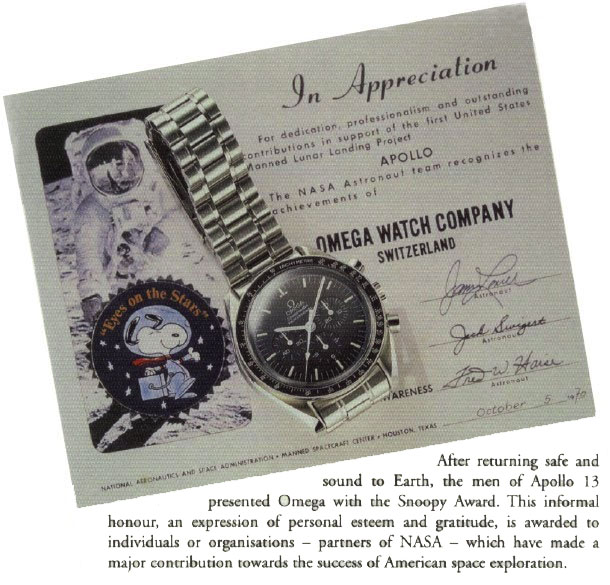
|
|
The
Snoopy Award signed by Lovell,
Haise and
Swigert...
|
- I do not
believe that Jack Swigert would have
signed the "Snoopy Award" if the award was
not deserved. I do not believe, especially
as a Rolex owner, that Jack Swigert would
perpetuate such a deception...
-
Special thanks to those people mentioned
above who have asked these questions. It is
only via the scrutiny of many that we burn
away impurities and are left with the
truth... --
Chuck
-
Statement
of rights retained and permissions
granted...
-
- Permission is
granted for Damon, Derek Ziglar, Frank N.,
Ross or Robert Jan to include within the
FAQ's they are writing as long as credit (and
a link to this article) is given. Permission
for personal, educational or noncommercial
use is granted. The author retains all other
rights not specifically mentioned here... For
all other use please contact
the author.
-
- Disclaimer:
Opinions, where expressed, are my own and
knowing me should be taken with a grain or
two of salt... --
Chuck
|
|



